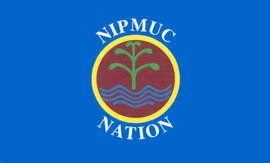Nipmuc
| Total population | |
|---|---|
| (354 Chaubunagungamaug, (2002) 526 Hassanamisco Nipmuc (2004). Possible total 1,400 (2008)) |
|
| Regions with significant populations | |
| Central Massachusetts ( |
|
| Languages | |
| Nipmuc, Massachusett, currently English. | |
| Religion | |
| Traditionally Animism (Manito), Christianity. | |
| Related ethnic groups | |
| Narragansett, Pocomtuc, Pennacook, Massachusett, and other Algonquian tribes. |
The Nipmuc or Nipmuck people are descendants of the indigenous Algonquian peoples of Nippenet, 'the freshwater pond place', which corresponds to central Massachusetts and immediately adjacent portions of Connecticut and Rhode Island. The tribe were first encountered by Europeans in 1630, when John Acquittamaug arrived with maize to sell to the starving colonists of Boston, Massachusetts.
The colonists introduced pathogens, such as smallpox, to which the Native Americans had no prior exposure. They were also exposed to alcohol for the first time, which led to huge numbers of natives succumbing to the effects of alcoholism. With the passage of increasingly harsh laws against Indian culture and religion, the loss of land, legally and illegally, to growing English colonies, many of the Nipmuc joined Metacomet's rebellion in 1675, the results of which were disastrous. Many of the Nipmuc were interned on Deer Island in Boston Harbor and perished, and others were executed or sold into slavery in the West Indies.
The Reverend John Eliot arrived in Boston in 1631 and began an ambitious project to learn the Massachusett language, widely understood throughout New England, convert the Native Americans, and published a Bible and grammar of the language. His efforts, with colonial government backing, established several 'Indian plantations' or 'Praying towns'—predecessors to the Indian Reservation—where the Native Americans were coerced to settle and instructed in English customs, Christianity, but governed and preached to by other Native Americans and in their own dialects. By the 19th century, the Nipmuc were reduced to wards of the state that were administered by state-appointed commissioners. The passage of the Massachusetts Enfranchisement Act of 1869 effectively 'detribalised' the Nipmuc, and the last of the remaining Indian plantation lands were sold. Nipmuc communities continued to survive, and the tribe received state recognition in 1979, but efforts at federal recognition have not met with success.
...
Wikipedia

